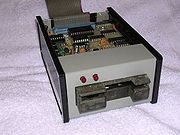
Stringy floppy
Encyclopedia

Tape drive
A tape drive is a data storage device that reads and performs digital recording, writes data on a magnetic tape. Magnetic tape data storage is typically used for offline, archival data storage. Tape media generally has a favorable unit cost and long archival stability.A tape drive provides...
that was developed by Exatron
Exatron
Exatron manufactures a complete line of automated handling, testing, programming, and marking equipment for the packaged integrated circuit industry....
for use with the Radio Shack
Radio shack
Radio shack is a slang term for a room or structure for housing radio equipment.-History:In the early days of radio, equipment was experimental and home-built. The first radio transmitters used a noisy spark to generate radio waves and were often housed in a garage or shed. When radio was first...
TRS-80
TRS-80
TRS-80 was Tandy Corporation's desktop microcomputer model line, sold through Tandy's Radio Shack stores in the late 1970s and early 1980s. The first units, ordered unseen, were delivered in November 1977, and rolled out to the stores the third week of December. The line won popularity with...
microcomputer
Microcomputer
A microcomputer is a computer with a microprocessor as its central processing unit. They are physically small compared to mainframe and minicomputers...
, among others, and was launched in 1979. The tape cartridge is about the size of a credit card, but about twice as thick. The magnetic tape itself was 1/16-inch wide.
According to Embedded Systems magazine the Exatron Stringy Floppy used Manchester encoding
Manchester code
In telecommunication and data storage, Manchester code is a line code in which the encoding of each data bit has at least one transition and occupies the same time...
, achieving 14K read-write speeds and the code controlling the device was developed by Li-Chen Wang
Li-Chen Wang
Dr. Li-Chen Wang is an American computer engineer, best known for his Palo Alto Tiny BASIC for Intel 8080-based microcomputers.This was the fourth version of Tiny BASIC that appeared in Dr. Dobb's Journal of Computer Calisthenics & Orthodontia, but probably the most influential. It appeared in the...
(who also wrote a Tiny BASIC
Tiny BASIC
Tiny BASIC is a dialect of the BASIC programming language that can fit into as little as 2 or 3 KB of memory. This small size made it invaluable in the early days of microcomputers , when typical memory size was only 4–8 KB.- History :...
, the basis for the TRS-80 Model I Level I BASIC.)
In the July 1983 issue of COMPUTE!'s Gazette
COMPUTE!'s Gazette
COMPUTE!'s Gazette was a computer magazine of the 1980s, directed at users of Commodore's 8-bit home computers. Publishing its first issue in July 1983, the Gazette was a Commodore-only daughter magazine of the computer hobbyist magazine COMPUTE!....
the ESF for the VIC-20 and the Commodore 64
Commodore 64
The Commodore 64 is an 8-bit home computer introduced by Commodore International in January 1982.Volume production started in the spring of 1982, with machines being released on to the market in August at a price of US$595...
was reviewed. The April 1983 issue of Creative Computing
Creative Computing
Creative Computing was one of the earliest magazines covering the microcomputer revolution. Published from 1974 until December 1985, Creative Computing covered the whole spectrum of hobbyist/home/personal computing in a more accessible format than the rather technically-oriented BYTE. The magazine...
reviews the Winter CES
Consumer Electronics Show
The International Consumer Electronics Show is a major technology-related trade show held each January in the Las Vegas Convention Center, Las Vegas, Nevada, United States. Not open to the public, the Consumer Electronics Association-sponsored show typically hosts previews of products and new...
show where Texas Instruments showed the TI Compact Computer 40
Texas Instruments Compact Computer 40
The Texas Instruments Compact Computer 40 or CC-40 is a battery-operated portable computer that was manufactured and released by Texas Instruments in March 1983. Priced at US$249, it weighs 600 grams and can be powered by four AA batteries or an AC adapter...
(CC-40) which included an optional peripheral, "a wafertape digital tape drive similar to the Exatron Stringy Floppy ($139)."
Exatron pitched the ESF as "The viable alternative". The ESF was faster and more reliable than a data cassette, and half the price of a floppy disk.

